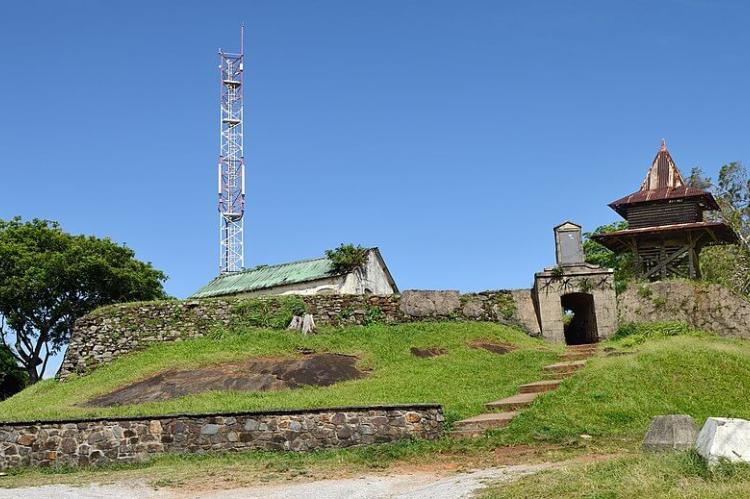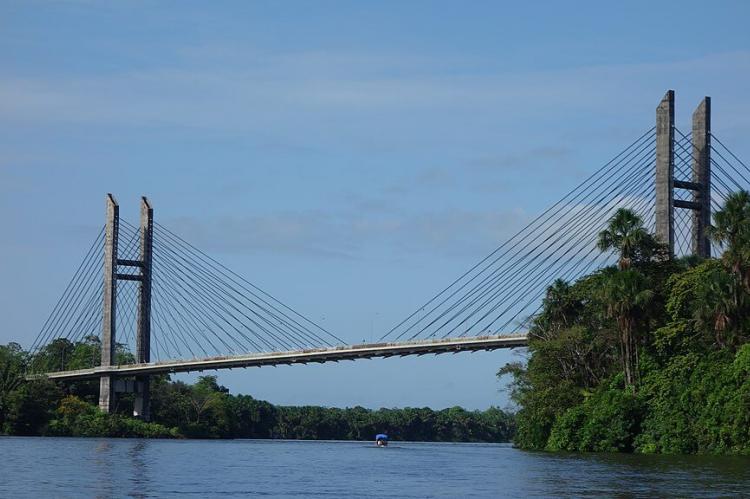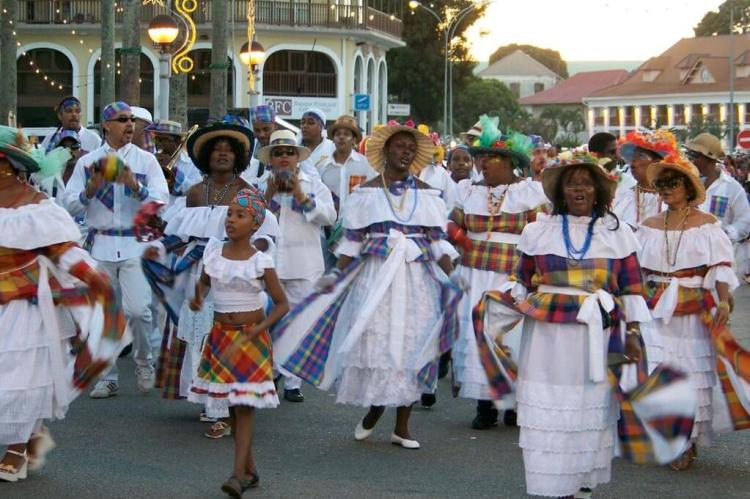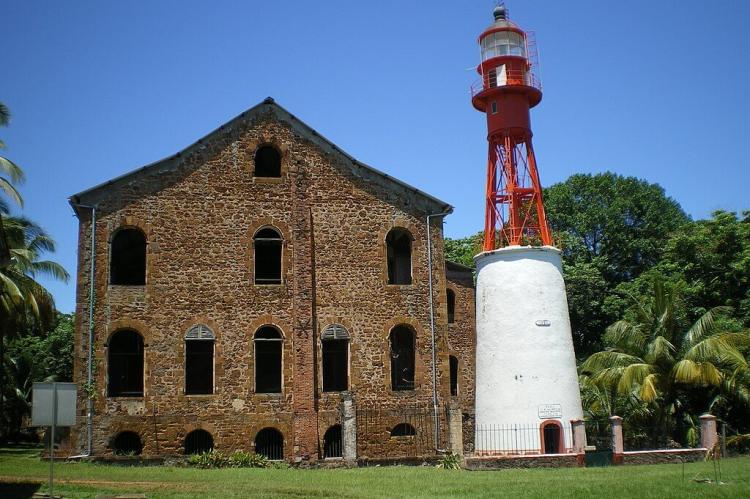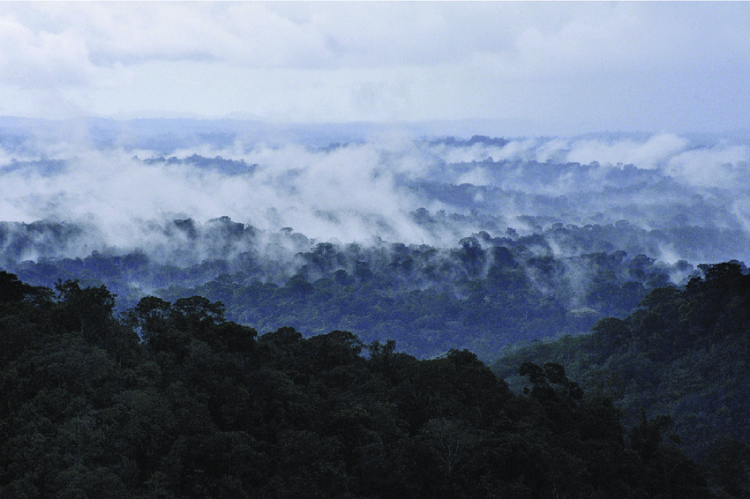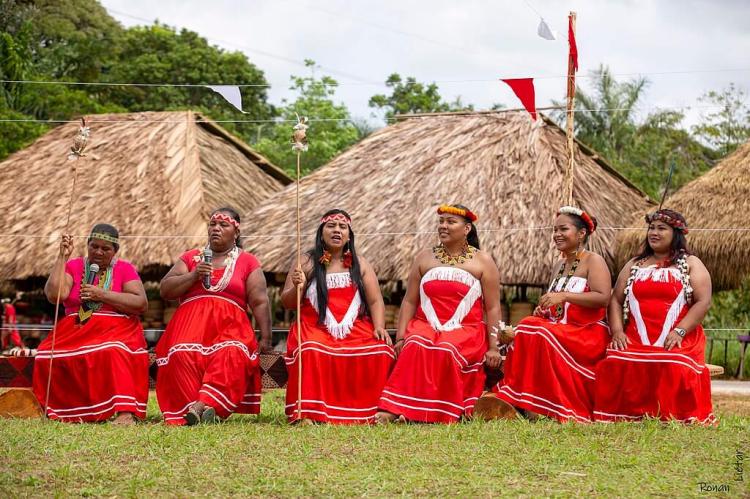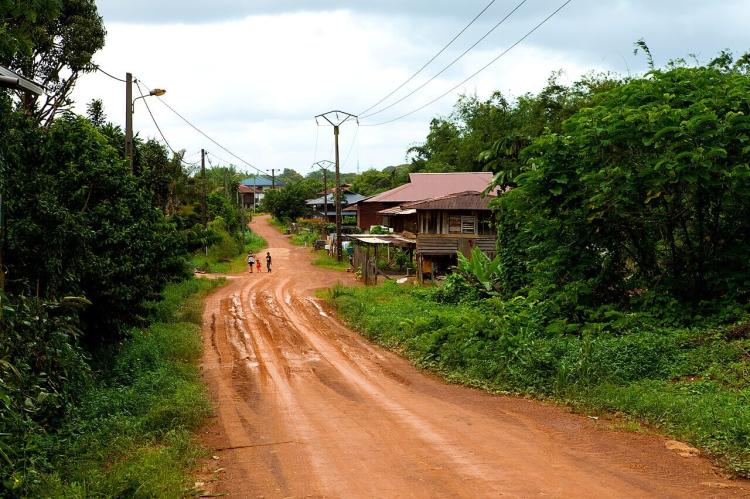French Guiana: Cultural Landscape
The cultural landscape of French Guiana (Guyane) is a fascinating blend of indigenous, African, European, and Asian influences, shaped by its historical legacy and multicultural population. This unique combination contributes to the region's vibrant traditions, languages, music, cuisine, and cultural richness.
The Cultural Landscape of French Guiana
French Guiana (Guyane) is an overseas department and region of France located on the northeastern coast of South America. It is part of the region known as "The Guianas," which includes Guyana and Suriname. French Guiana's cultural landscape is a fascinating blend of indigenous, African, European, and Asian influences shaped by its diverse population and historical background.
-
Indigenous Heritage: Before European colonization, French Guiana was inhabited by various indigenous tribes, including the Arawak, Wayana, and Palikur. These indigenous cultures have significantly impacted the region's cultural identity, with their traditional practices, art, and spirituality still celebrated and preserved by local communities.
-
African and Creole Influence: The history of French Guiana is closely intertwined with the transatlantic slave trade. Enslaved Africans were brought to the region to work on plantations, and their cultural heritage strongly influenced the local culture. Creole languages, music, dance forms like the Gwo Ka, and traditional cuisine reflect the African roots of the population.
-
European and French Influence: French Guiana remains integral to France, and French influence is pervasive in the region's cultural landscape. French is the official language, and French customs and traditions are widely observed. European architectural styles, particularly in the capital city of Cayenne, can be seen in colonial buildings and churches.
-
Indigenous and Traditional Knowledge: The indigenous communities of French Guiana possess a deep knowledge of the local environment and traditional practices. They have a rich understanding of medicinal plants, hunting techniques, and sustainable farming methods. The preservation and revitalization of indigenous knowledge are essential aspects of the cultural landscape.
-
Festivals and Celebrations: French Guiana celebrates various festivals and events showcasing cultural diversity. For example, Carnival, influenced by African traditions, is a vibrant and colorful celebration featuring parades, music, dancing, and elaborate costumes. The Maroon Festival, called "Pakala," is another significant event that honors the history and heritage of the Maroon communities.
-
Cuisine: French Guianese cuisine is a fusion of diverse culinary traditions. Local dishes often incorporate cassava, plantains, fish, and spices, reflecting indigenous and African influences. Traditional dishes like "civet de pécari" (peccary stew) and "calalou" (leafy greens stew) are examples of the region's gastronomic heritage.
-
Biodiversity and Ecotourism: French Guiana is renowned for its exceptional biodiversity, boasting pristine rainforests, rivers, and diverse ecosystems. The natural beauty and unique wildlife attract ecotourism enthusiasts and researchers worldwide. In addition, indigenous communities play a vital role in preserving the region's natural heritage and offering immersive cultural and ecotourism experiences.
Contemporary Influences on French Guianan Culture
These are just some of the contemporary influences on French Guianan culture. It is important to note that these influences are not always negative. They often lead to positive changes in French Guianese society and culture.
-
Globalization: Globalization is having a significant impact on French Guianan culture. French Guianans are increasingly exposed to foreign cultures through the media, travel, and immigration. This exposure is leading to a blending of French Guianan culture with other cultures and is also leading to the erosion of some traditional French Guianan customs.
-
Technology: Technology is also having a significant impact on French Guianan culture. French Guianans increasingly use technology to communicate, learn, and entertain themselves. This use of technology is changing the way French Guianans live and interact with each other, leading to the spread of new ideas and trends.
-
Economic Development: Economic development is also having an impact on French Guianan culture. As the French Guianese economy grows, more French Guianans can afford to travel, buy new products, and access education and healthcare. This increased affluence is leading to changes in French Guianan lifestyles and values and is also leading to the spread of new ideas and trends.
-
Migration: Migration is another significant influence on French Guianan culture. Millions of French Guianans have migrated to France and other countries for a better life. This migration has led to the spread of French Guianan culture to other parts of the world and has significantly impacted French Guianese society and culture.
Challenges Facing French Guianan Culture
These are just some of the challenges facing French Guianan culture. It is crucial to address these challenges to protect and preserve French Guianan culture for future generations.
-
Poverty: French Guiana is one of the poorest regions in France, with a poverty rate of over 25%. This poverty negatively affects French Guianan culture, including limited access to education and healthcare, increased crime and violence, and outmigration.
-
Isolation: French Guiana is a remote region located on the Atlantic coast of South America. This isolation can make it difficult for French Guianans to connect with other cultures and learn about new ideas.
-
Colonization: France colonized French Guiana for over 200 years. This colonization profoundly impacted French Guianan culture; many aspects of traditional French Guianan culture have been lost or eroded.
-
Globalization: Globalization is having a mixed impact on French Guianan culture. On the one hand, it opens up new opportunities for French Guianans to connect with the world and learn about different cultures. On the other hand, it also leads to the erosion of traditional French Guianan culture.
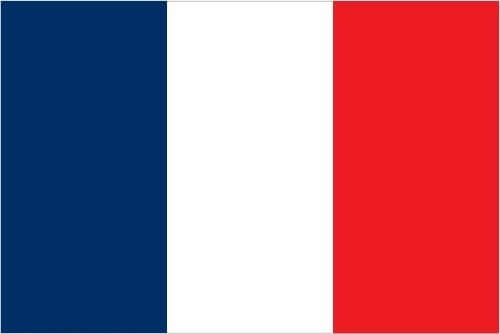
The official flag of French Guiana (France)
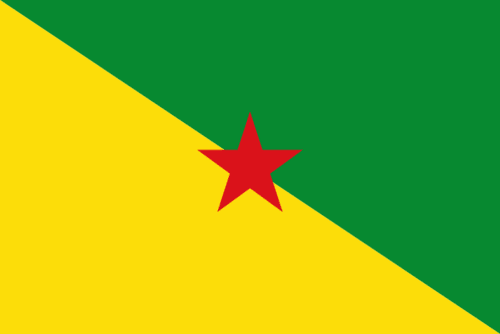
The flag of French Guiana (unofficial)
Cultural Geography of French Guiana
Largest Cities / Metro Areas
Ranked by population estimate (2023):
-
Cayenne (61,550): Cayenne is the capital of French Guiana. The city stands on a former island at the mouth of the Cayenne River on the Atlantic coast. Cayenne is the largest urban area in French Guiana and serves as its administrative, economic, and cultural center.
-
Matoury (26,350): Matoury is located just south of the capital city, Cayenne, and is considered part of the Cayenne metropolitan area. As a growing city, Matoury has seen significant development in recent years. As a result, it features a mix of modern infrastructure and traditional Creole-style houses.
-
Saint-Laurent-du-Maroni (24,287): Saint-Laurent-du-Maroni is a city in the western part of French Guiana. It is situated on the Maroni River, which forms the border between French Guiana and Suriname. Saint-Laurent-du-Maroni is the second-largest city in French Guiana and is an important economic and administrative center in the region.
-
Kourou (24,029): Kourou is located on the northeastern coast of French Guiana, approximately 60 km (37 mi) northwest of the capital city, Cayenne. Kourou is internationally renowned as the Centre Spatial Guyanais (CSG) site, the European spaceport.
-
Remire-Montjoly (19,029): Remire-Montjoly is located on the northeastern coast of French Guiana, just east of the capital city, Cayenne, and is considered part of the metropolitan area of Cayenne. Remire-Montjoly is known for its beautiful beaches, rich biodiversity, and tranquil atmosphere.
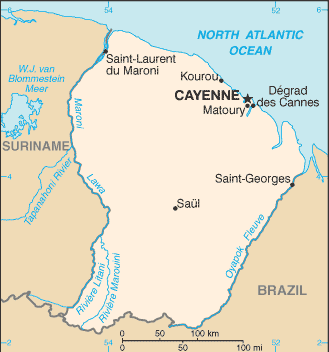
CIA map of French Guiana
Administrative Divisions
French Guiana is divided into three arrondissements:
-
Arrondissement of Cayenne: This arrondissement is the most populous and urbanized in French Guiana. It includes the capital city of Cayenne and its surrounding areas.
-
Arrondissement of Saint-Laurent-du-Maroni: This arrondissement is located in the north and west of French Guiana, along the Maroni River.
-
Arrondissement of Saint-Georges: This arrondissement was created in October 2022 and is located in the south and east of French Guiana, along the Oyapock River.
Each arrondissement is subdivided into a total of 22 cantons as follows:
Saint-Laurent-du-Maroni:
- Awala-Yalimapo
- Mana
- Saint-Laurent-du-Maroni
- Apatou
- Grand-Santi
- Papaïchton
- Saül
- Maripasoula
Saint-Georges:
- Camopi
- Saint-Georges
- Ouanary
- Régina
Cayenne:
- Roura
- Saint-Élie
- Iracoubo
- Sinnamary
- Kourou
- Macouria
- Montsinéry-Tonnegrande
- Matoury
- Cayenne
- Remire-Montjoly

French Guiana (Guyane) administrative map
Border Dispute
French Guiana and Suriname are involved in a territorial dispute regarding the southern portion of their border. Suriname claims approximately 13,000 sq km (5,000 sq mi) between the Litani and Maroni rivers in the southwest corner of French Guiana.
Geographic Regions (Zones)
French Guiana consists of two main geographical regions or zones:
-
Coastal Lowlands: a coastal strip in the north along the coast, where most of the population lives
-
Interior Region: a dense rainforest to the south that gradually rises to the Tumac-Humac mountains near the Brazilian border
See more: Natural Landscape of French Guiana
Historical, Cultural, and Natural Landmarks
French Guiana, an overseas department of France, has a unique blend of historical, cultural, and natural landmarks. Here are some notable examples:
Coastal Lowlands
The Coastal Lowlands Region of French Guiana is a diverse and ecologically significant area located along the northeastern coast of South America. It is characterized by a unique blend of coastal ecosystems, including mangroves, marshes, estuaries, and pristine beaches. Here are some highlights and notable features of the Coastal Lowlands Region:
- Cayenne: The capital city of French Guiana, Cayenne, has a historic district with colonial architecture, including the Place des Palmistes and the Cayenne Cathedral. The city also houses the Tropenmuseum, which focuses on the history and culture of the region.
-
Montjoly Beach: One of the most beautiful beaches in French Guiana, Montjoly Beach is known for its stunning white sand and turquoise waters. It is a popular destination for sunbathing, swimming, and picnicking.
-
Awala-Yalimapo: Awala-Yalimapo is a small village known for its sea turtle nesting sites on the northwest coast. The beaches here provide nesting grounds for endangered leatherback turtles, and visitors can witness the incredible spectacle of turtle nesting and hatching during the nesting season.
-
Réserve Naturelle des Marais de Kaw-Roura: This nature reserve is a vast wetland area encompassing mangroves, marshes, and swamps. It is home to a rich diversity of flora and fauna, including various bird species, caimans, and manatees. The reserve is an essential habitat for migratory birds and is a designated Ramsar site.
-
Îles du Salut (Salvation Islands): Located a few kilometers off the coast of French Guiana, the Îles du Salut consists of three small islands: Île Royale, Île Saint-Joseph, and Île du Diable (Devil's Island). These islands were historically used as penal colonies and are known for their intriguing history, lush vegetation, and beautiful landscapes. Visitors can explore the ruins of the former prison buildings and enjoy the picturesque surroundings.
Interior Region
The Interior Region of French Guiana is a vast and largely uninhabited area characterized by dense rainforests, rivers, and wetlands. This region has diverse ecosystems and unique wildlife, offering a rich natural heritage. Here are some highlights and protected areas within the Interior Region of French Guiana:
Natural Landmarks
-
Guiana Amazonian Park (Parc Amazonien de Guyane): As mentioned earlier, the Guiana Amazonian Park is the largest national park in France and covers a significant portion of the Interior Region. It protects an immense area of pristine rainforest, rivers, and savannahs, providing a sanctuary for numerous endangered species and serving as a vital part of the Amazon rainforest ecosystem.
-
Tumuc-Humac Mountains: The Tumuc-Humac Mountains form the southern border of French Guiana, extending into the Interior Region. This mountain range is part of the larger Guiana Shield and is characterized by rugged terrain, dense rainforests, and towering peaks. While not primarily located within French Guiana, the Tumuc-Humac Mountains offer opportunities for hiking, wildlife spotting, and exploring the untouched wilderness.
-
Maroni River: The Maroni River flows through the Interior Region, serving as a natural border between French Guiana and Suriname. Dense rainforests surround this mighty river, an essential waterway for local communities. The Maroni River and its surrounding areas offer opportunities for river cruises, fishing, and exploring the rich biodiversity along its banks.
-
Inini River: The Inini River is another significant waterway in the Interior Region, known for its remote and pristine nature. It is a tributary of the Maroni River and meanders through the rainforests, providing canoeing, kayaking, and wildlife observation opportunities.
-
Amana Nature Reserve (Réserve Naturelle d'Amana): Located in the central part of the Interior Region, the Amana Nature Reserve protects a vast area of primary rainforest and wetlands. It is home to various flora and fauna, including the Guiana dolphin, giant river otter, and numerous bird species. The reserve offers guided tours and allows visitors to explore its natural wonders while promoting conservation and sustainable practices.
-
Saut Maripa: Saut Maripa is a stunning waterfall in the Interior Region's heart. It is renowned for its impressive cascade, surrounded by lush greenery and towering cliffs. The area around Saut Maripa provides opportunities for hiking, photography, and experiencing the raw beauty of French Guiana's interior.
Cultural Landmarks
-
Maroon Communities: French Guiana is home to various Maroon communities, descendants of escaped enslaved Africans. Villages like Cacao and Saint-Laurent-du-Maroni provide a glimpse into the unique culture, music, and traditions of the Maroon people.
-
Hmong Community: French Guiana is also home to a significant Hmong community, who settled in the region after the Vietnam War. Visitors can experience Hmong culture and cuisine in places like Cacao and Saint-Laurent-du-Maroni.

